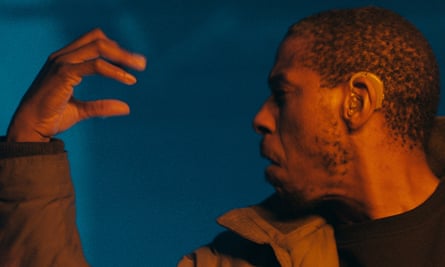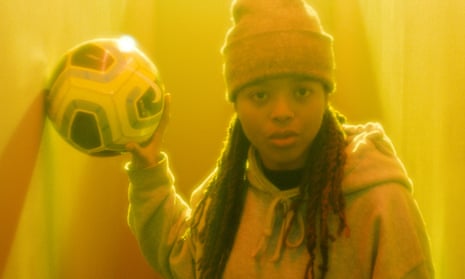Addressing the camera, Ryan Pendley’s arms swipe the air, his hands fly with ferocity and pent-up frustration, his fingers crawl up his neck and clasp over his mouth. The subtitle explains, “like struggling to breathe”, but you hardly need the translation. What we’re watching looks like sign language, mime and dance rolled into one. It’s actually visual vernacular, or VV, an art form little known beyond the Deaf community (Deaf, with a capital D, refers to a distinctive culture as opposed to a solely audiological condition). And it’s part of a new film Here/Not Here by director Bim Ajadi, that finds connections between three seemingly disparate physical languages: krump dance, football and British Sign Language (BSL).
Ajadi, who is profoundly deaf, brings together these three passions of his in a bigger story about three groups of young people who clash over the use of an abandoned warehouse space, with a script by hip-hop theatre pioneer Jonzi D. Ajadi explicitly wanted to bring VV in to the mainstream. He calls it a form of visual poetry but he could see the connection with dance and its potential appeal beyond signers. “It’s a way of expressing visual vignettes,” he says, through an interpreter over a video call. He describes how Deaf people growing up in the 70s and 80s, watching television with no subtitles, would take the shows in visually “and almost have their own version of the story. And when they would communicate back to other Deaf friends they would describe that using VV.” The gestures can work like a storyboard, with cinematic effects, zooming in or out or switching between characters in a scene.

VV has been around for decades and is more widespread in Europe and the US, where there are festivals, showcases and the ASL (American Sign Language) Slam, the equivalent of an MC battle. “But it’s definitely starting to grow within the Deaf community in the UK,” Ajadi says, “we’ve seen a surge in interest.”
VV has similarities to krump, the powerfully explosive street dance style that appears in the film (led by dancer Theo ‘Godson’ Oloyade, part of a cast mixing pro and amateur actors). Both have a basic grammar and use improvisation around that, often in a battle format. In the film, the spark that links the two forms and unites the rival groups comes via tutting, a dance that uses deft and complex movements of the fingers to make images, symbols and patterns.

Described as a “hip-hop drama”, Here/Not Here comes with a message about overcoming our differences to find common ground and packs a lot of issues into 30 minutes: primarily the question of space, and who has it – so pertinent now during lockdown, but originally spurred by the closure Ajadi has seen of Deaf clubs and centres. It addresses how quick we can be to judge others. “I think that’s a common experience, especially in terms of race and certainly for the Deaf community,” says Ajadi. The awkwardness of first communication between Deaf and hearing characters isn’t something you see often on screen. “That was really important to me,” he says, “just in terms of representing how that communication can be brokered quite easily, I think that’s missing in a lot of mainstream film.”

Comments (…)
Sign in or create your Guardian account to join the discussion